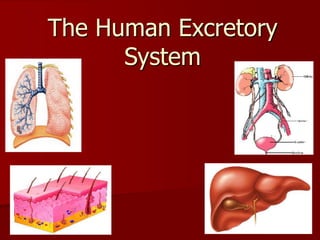
The Human Excretory System Notes.ppt
- 2. What is Metabolism? Metabolism is the biochemical modification of chemical compounds in living organisms and within living cells. Metabolism includes the biosynthesis of complex organic molecules (anabolism) and their breakdown (catabolism). Metabolism usually consists of sequences of enzymatic steps, also called metabolic pathways. The total metabolism are all biochemical processes of an organism.
- 3. What is Homeostasis? Homeostasis is the property of an open system, especially in living organisms, to regulate its internal environment to maintain a stable, constant condition, by means of multiple dynamic equilibrium adjustments, controlled by interrelated regulation mechanisms.
- 4. Excretion During normal metabolism, many waste products are produced that must be eliminated by the body. During excretion toxic chemicals and excess water, salts, and carbon dioxide are removed from the body. This is done to maintain both osmotic and pH balance.
- 5. Organs of Excretion The lungs excrete excess carbon dioxide and water vapor from the body. Both wastes leave the body during exhalation.
- 6. Organs of Excretion The liver removes nitrogen wastes (NH3) from the blood that result from the break down of amino acids. In the liver ammonia (NH3) is converted to a less toxic substance called urea, then can be carried more safely in the blood to the kidneys where it is finally removed as a part of urine. Breaks down other toxins that are in the body.
- 7. Organs of Excretion Breaks down old red blood cells. When the liver is overworked it becomes diseased. If the liver fails to function properly a person will die. It is a resilient organ and can regenerate itself to some extent. A person can still live with only 30% of the liver functioning properly. Lower than 30% of the liver functioning will result in death.
- 8. Organs of Excretion The kidneys excrete nitrogenous wastes (urea), salts, water, and other substances that make up urine.
- 9. Organs of Excretion Each kidney is about the size of fist. Each kidney is made up of about a million microscopic units called a nephron. Nephrons are tiny cup shaped capsules surrounded by capillaries. As blood flows through the nephron the following occurs: filtration, reabsorption, secretion, and urine formation.
- 10. Organs of Excretion Filtration takes place in glomerulus. The pressure from the arteries (heart) forces water, salt, amino acids, glucose, and urea is forced out of the blood. Blood cells and protein remain in the blood they are too big to be filtered out. Reabsoprtion of some of the filtrate occurs in the Bowman’s capsule. As the filtrate passes through the nephron, 99% of water, glucose, amino acids and salts are reabsorbed. Whatever is left (water, urea and some salts) becomes urine. Urine that is produced leads to ducts that lead to ureters that connect to the bladder. When the bladder is full a person will urinate. When the kidney fails, the other kidney will enlarge to compensate. When both fail, a person will need a kidney transplant or will have to be put on dialysis.
- 11. Organs of Excretion A Nephron
- 12. Organs of Excretion Background Information Skin is the largest organ in the body. It protects the body, and has a role in keeping conditions with in the body constant. There are two layers or skin. As new skin cells are created they push the older ones to the surface. Layers beneath the surface pigments that give skin its color. Glands in the skin release oils that keep hair soft.
- 13. Organs of Excretion Background Information There are structures in the skin that maintain homeostasis, Nerve endings detect temperature and touch. Hair and capillaries in the skin regulate body temperature. Sweat glands release sweat to regulate body temperature. Also wastes are excreted through sweat.
- 14. Organs of Excretion The skin excretes sweat, which is a mixture of water, salts, small amount of nitrogen wastes (urea), and other trace substances.